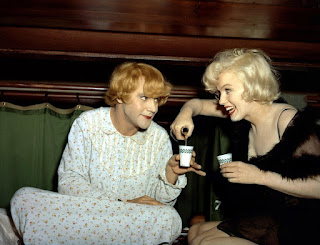Jack Lemmon, the star of Some Like It Hot, The Apartment and The Odd Couple was among the first to know that Marilyn Monroe was having an affair with President John F Kennedy. Lemmon used to live at silent movie star Harold Lloyd’s old house. He recalled: “One day I was coming back home and there’s this helicopter doing a low lazy circle above it. And there were these guys in funny suits and funny glasses, standing around watching Marilyn and JFK having a frolic in the pool.” Marilyn, as it turned out, wasn’t remotely embarrassed that he had seen her naked in the pool with the President.
One man who wasn’t wild about Marilyn was the singer who’d married two stars in succession — Debbie Reynolds and Elizabeth Taylor — and he’d learned quite a bit about the seamier side of Hollywood. Marilyn, Eddie Fisher told me, was "a user" — reeling in men who could be useful to her, then discarding them when they’d served their purpose. “Marilyn Monroe was a serious player. She used people — she played them off, and I was a victim, too. When I first met her at the start of the Fifties, she made a beeline for me and asked me out on many occasions for a date. But she wasn’t the ‘Marilyn’ creation then — pretty but fake.”
“One thing about Marilyn,” Joan Rivers said, “was that she wasn’t a great gay fan: she loathed the idea that some men might not find her attractive. I told her about my gay pals and she looked bemused. She had a hard time even believing Rock Hudson was gay.” Like Debbie Reynolds, Joan Rivers was convinced Marilyn was murdered. “Sure, she was a pill addict and had problems, but none of the story of her death stacks up. I blame the Kennedys: without a doubt, she got mixed up in some terrible trouble. Given all she had going for her, why would she suddenly kill herself? She wasn’t the type to do it.” Source: www.dailyo.in
In the preface to his new book Moment by Moment, former LIFE photographer John Loengard notes that the thing about a good photograph is that it cannot be repeated. What it captures will never happen again, though now it is frozen in time by the image. “That may explain why an image of a brief moment, an instant in time, can hold our interest forever,” he writes. Loengard’s latest book is a survey that takes a closer look at a variety of the many iconic images he has created during the last 60 years. It is filled with quiet, intimate moments, from a laughing Marilyn Monroe to a young boy turning his head at the sound of his mother calling. Pictured on the cover is the famous photo of the Beatles in a swimming pool at Miami Beach in 1964. This photo in fact never ran on the cover of LIFE magazine – although as illustrated here, it is certainly cover worthy — but ran in the back of the book as a Miscellany. Source: time.com
Buddy Holly embodied, as much as James Dean or Marilyn Monroe, the central conflict of the 1950s: conformity with establishment values versus individuality/rebellion. While he wore leather and rode a motorcycle, he was a devout fundamentalist Christian, hounded by a puritanical conscience that condemned rock and roll as evil. Perhaps it was this innate contradiction that made him so great. The songs Buddy Holly wrote and sang are among the most original and ecstatic Rock would ever know. Buddy tried out contact lenses in 1956, but they were very uncomfortable back in those days —so he stuck to glasses. And under those big-framed black horn-rims he adopted, there was a very good-looking young man. I was intrigued by the close-up of Buddy with his trademark glasses and movie star good looks. —"The Life and Music of Rock ’n’ Roll Pioneer Buddy Holly" (2009) by Staton Rabin and "Words of Love 1959-2009" (2010) by Gary Clevenger
Jive Bunny - Ultimate Christmas Party. Jive Bunny and the Mastermixers use songs sampling and synthesisers to combine pop music from the early rock and roll era together into a medley.
John Beecher: Personally, my big disappointment would be that the hopes we had in the ‘50s and ‘60s, that there would be a better world and that people would learn to live together, have pretty well been dashed in recent years. Thank goodness we still have the music that will never change—those same records we first heard then are still important to me and it's good to know that Danny and The Juniors got it just right when they sang, "Rock ‘n’ Roll will never die." Source: www.musicdish.com
Memories are precious. The self-reported uses of autobiographical memory. They bond relationships, contribute to a sense of identity, and shape current decisions and future planning. Memories may also seem eternal, like cherished photographs in an album we peruse from time to time. Our memories play major roles in making us who we are. Our beliefs about our personal histories both reflect and constitute central aspects of ourselves. Practitioners (e.g., police officers, medical personnel, career guidance counsellors, historians, and political scientists), in a variety of everyday settings routinely rely on individuals’ autobiographical memory reports sometimes basing extremely consequential decisions on individuals’ reports of their personal histories. Yet remembering the past is a complex phenomenon that is subject to error. Source: www.tandfonline.com
I tried forgetting what you meant to me / For now I realize that I'm alone / In my mind I really know that you are gone / But my foolish heart refuses to see / Why you've left me alone with memories - "Memories" by Buddy Holly, written in the early 1950s. From the album "Holly In The Hills" (1965)




















No comments :
Post a Comment